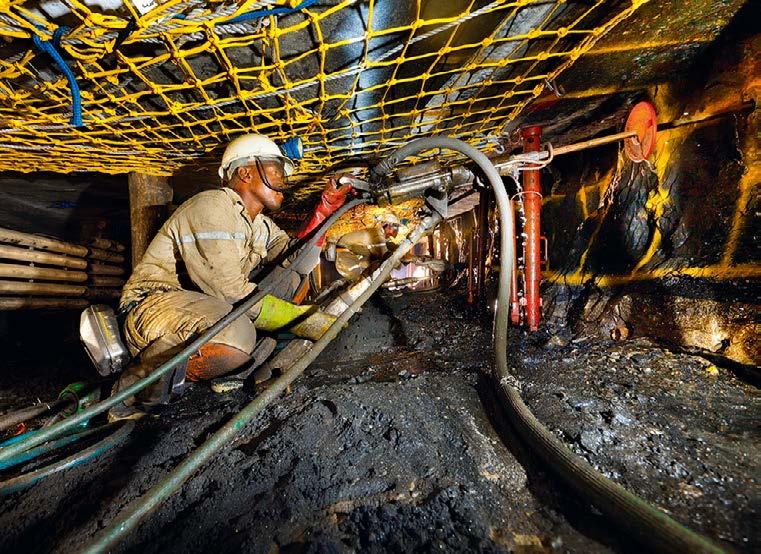
5 minute read
Is there an opportunity to build back South Africa’s mining industry?
GLOBAL
Is there an opportunity to build back South Africa’s mining industry?
The mining industry in South Africa may have shown resilience and weathered the Covid-19 hurricane, but businesses, particularly when it comes to environmental, social and governance (ESG) problems, still continue to concentrate on their strategies.
This is according to a new study on the status of the mining sector in the world by PwC. The study portrays the industry in a favorable light, noting that mining companies stayed resilient and delivered on all fronts during an incredibly difficult year. Stakeholders gained from increased profitability by strengthening their true social license to act in favor of their workers and the societies in which they reside with mining companies. The COVID-19 storm has been weathered by the mining industry, largely unscathed and definitely stronger than many other industries. Learn more regarding the role of COVID19 on the mining business. It should be remembered that before the COVID-19 pandemic, the South African economy was still in a slump, with the country's GDP contraction for three consecutive quarters culminating in March 2020. At this time, the contribution of the mining sector to GDP decreased by three quarters year on year (YOY) in both of the recessions. The second quarter of 2020 began with a 51.2 percent decrease in hard lockdown and mining output and revenue by 28.8 percent YOY in April as government legislation restricted industrial operation only to critical resources, with maximum capacity working only coal mines. As more mines were permitted to open, the fall in mineral production and sales eased to 27.6 percent YOY and 12.2 percent YOP
under Lockdown Stage 4, respectively. In June, under Lockdown Level 3, the majority of mines were able to return to 100 percent output, while production and revenues were still down 28.2 percent YOY and 14.2 percent YOY, owing to technical restrictions and foreign market conditions, respectively.
Amid a relatively gloomy forecast, as platinum basket prices rose and investors switched to gold as a safe haven secu-
rity amid worries about the COVID-19 10 | SKILLINGS MINING REVIEW January 2021 pandemic and global trade conflicts, mining firms continued to enjoy increases in commodity prices, supported by a weakened rand. Some of the keys to the reports are:
CAPITALISATION OF THE SECTOR
Total market capitalisation has risen from R840 billion to R1 280 billion in 2020. This sum is a YOY rise of R439 billion (52 percent) from 2019, primarily due to the increase in market capitalization of gold and PGM industry firms. Gold and PGM accounted for 80 per cent of the examined companies' market capitalisation this year and appear to lead the business.
FINANCIAL PRODUCTION
For the year ended 30 June 2020, the overall revenue produced by the South African mining industry increased by 4% . It was largely powered by PGMs, gold and iron ore, which for the 12-month cycle witnessed sales rises. The largest portion of revenue was generated by PGM (28 percent), showing a 56 percent rise from
the previous year, overtaking coal for the first time since 2010. Gold mining firms saw a sales boost of 35 percent. Revenue rose by 7% for the other mining' divisions.
As of April 2020, the effect of the COVID-19 pandemic was apparent, with industry-wide sales declines being seen. PGMs and gold from South Africa are primarily extracted in deep-level surface mines and have thus been struck hardest. The producers of PGM and gold have stated that they plan to hit maximum rate of output by the end of the year.
MANUFACTURING
Output decreased by 8% YOY, with a 44% decrease in performance recorded as a consequence of the pandemic in April 2020, the most important of which was attributed to declines in gold, diamonds and PGM production. Since the relaxation of lockout limits, production volumes rose in May 2020.
THE EQUIVALENT OF HYDROGEN
The study reports that hydrogen has been attracting interest for quite some time in South African mines. Several transport projects in the sector have been conducted that are strongly focused on the usage of PGMs in fuel cell catalysts.
LEARN ALL ON SOUTHERN AFRICAN MINES
Although these pilot projects are a successful start to introduce hydrogen technology into mines, the focus of their deployment is very limited, with only the transport component of a mining activity being decarbonized. As such, there is a far greater potential to exploit hydrogen's cross-sector advantages on a microgrid scale, building a truly green and resilient mining activity. "Now may be the right time for mining companies to consider the enormous benefits of hydrogen, given that the cost of producing renewable hydrogen is expected to fall by up to 60% over the next decade," notes the paper.
MINING SAFELY
According to the study, the value of prioritizing environmental, social and governance (ESG) issues on the corporate For mining and future benefit prospects, liberalization of the energy sector to ensure stable and costcompetitive electricity is important. In addition, changes in the regulatory climate can proceed with the need for process streamlining and accountability enhancements for current and future investors.

agenda has been steadily recognized by corporations and investors. The study describes four main ESG priority areas that should be top of mind for any enterprise that wants to better reconstruct and maintain a fair transition to a new environment and boost their social license to operate.
There are: 1) stability in the supply chain; 2) effect measurement; 3) threats associated with the climate; and 4) quality of capital.
The study reveals, however, that while mining companies are sometimes at the forefront of ESG activities, when it comes to setting goals and assessing themselves, they are poor in their reporting. The COVID-19 pandemic called for a renewed government and company emphasis on enhancing the lives of citizens and strengthening local communities. As such, this suggests a need for ESG to be taken into consideration in its entirety. The pandemic emphasized the utter necessity to "build back better." In the recovery, mining can play a key role. It is also unfortunate that capital spending has only risen slightly, considering the increased profitability. Although a conservative attitude is understandable, it is important to eliminate impediments to investment. For mining and future benefit prospects, liberalization of the energy sector to ensure stable and cost-competitive electricity is important.
In addition, changes in the regulatory climate can proceed with the need for process streamlining and accountability enhancements for current and future investors."The additional report states, "The mining tax environment as a whole should be regarded, with an incentive to
promote exploration investment. It will have instant recovery benefits and increase long-term viability by enabling utilities, promoting the supply chain and mine-to-market logistics.It is only feasible to draw investment if the SA mining sector will be cost-competitive with its global peers.










